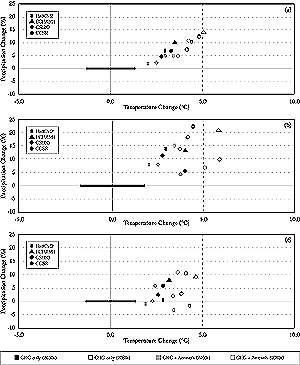11.1.3.3. Precipitation

Figure 11-6: Projected changes in area-averaged annual (a) and seasonal
[(b) DJF and (c) JJA)] mean surface air temperature and precipitation over
land regions of Asia for the 2050s and 2080s as obtained in select AOGCMs.
|
In general, all AOGCMs simulate an enhanced hydrological
cycle and an increase in annual mean rainfall over most of Asia (Giorgi and
Francisco, 2000). An area-averaged annual mean increase in precipitation of
3±1% in the 2020s, 7±2% in the 2050s, and 11±3% in the
2080s over the land regions of Asia is projected as a result of future increases
in the atmospheric concentration of GHGs. Under the combined influence of GHGs
and sulfate aerosols, the projected increase in precipitation is limited to
2±1% in the decade 2020s, 3±1% in the 2050s, and 7±3% in
the 2080s. Figure 11-6 depicts projected changes in precipitation
relative to changes in surface air temperature, averaged for land regions of
Asia for each of the four skilled AOGCMs on an annual mean basis as well as
during winter and summer for the 2050s and 2080s. The increase in precipitation
is maximum during NH winter for both the time periods (Lal and Harasawa, 2000b).
Clearly, intermodel differences in projections of precipitation are relatively
large particularly during the winter even when they are averaged for the entire
Asian continent—suggesting low confidence in projections of future precipitation
in current AOGCMs.
The increase in annual mean precipitation is projected to be highest in boreal
Asia. During the winter, boreal Asia and the Tibetan Plateau have the most pronounced
increase in precipitation (Table 11-2). Over central
Asia, an increase in winter precipitation and a decrease in summer precipitation
are projected. Because the rainfall over this region is already low, severe
water stress conditions—leading to expansion of deserts—are quite
possible with a rise in surface air temperature here. The area-averaged annual
mean and winter precipitation is projected to increase in temperate Asia. The
models show high uncertainty in projections of future winter and summer precipitation
over south Asia (with or without direct aerosol forcings). The effect of sulfate
aerosols on Indian summer monsoon precipitation is to dampen the strength of
the monsoon compared to that seen with GHGs only (Lal et al., 1995a; Mitchell
et al., 1995; Cubasch et al., 1996; Roeckner et al., 1999). The overall effect
of the combined forcing is at least partly dependent on the land/sea distribution
of aerosol forcing and on whether the indirect effect is included along with
the direct effect. To date, the effect of aerosol forcing (direct and indirect)
on the variability of the monsoon has not been investigated.
Recent observations suggest that there is no appreciable long-term variation
in the total number of tropical cyclones observed in the north Indian, southwest
Indian, and southwest Pacific Oceans east of 160°E (Neumann, 1993; Lander
and Guard, 1998). For the northwest subtropical Pacific basin, Chan and Shi
(1996) found that the frequency of typhoons and the total number of tropical
storms and typhoons has been more variable since about 1980. Several studies
since the SAR have considered likely changes in tropical cyclones (Henderson-Sellers
et al., 1998; Knutson et al., 1998; Krishnamurti et al., 1998; Royer et al.,
1998). Some of these studies suggest an increase in tropical storm intensities
with carbon dioxide (CO2)-induced warming.
Some of the most pronounced year-to-year variability in climate features in
many parts of Asia has been linked to ENSO. Since the SAR, analysis of several
new AOGCM results indicates that as global temperatures increase, the Pacific
climate will tend to resemble a more El Niño-like state (Mitchell et
al., 1995; Meehl and Washington, 1996; Knutson and Manabe, 1998; Boer et al.,
1999; Timmermann et al., 1999). Collins (1999) finds an increased frequency
of ENSO events and a shift in their seasonal cycle in a warmer atmosphere: The
maximum occurs between August and October rather than around January as currently
observed. Meehl and Washington (1996) indicate that future seasonal precipitation
extremes associated with a given ENSO event are likely to be more intense in
the tropical Indian Ocean region; anomalously wet areas could become wetter,
and anomalously dry areas could become drier during future ENSO events.
Several recent studies (Kitoh et al., 1997; Lal et al., 2000) have confirmed
earlier results (Kattenberg et al., 1996) indicating an increase in interannual
variability of daily precipitation in the Asian summer monsoon with increased
GHGs. Lal et al. (2000) also report an increase in intraseasonal precipitation
variability and suggest that intraseasonal and interannual increases are associated
with increased intraseasonal convective activity during the summer. The intensity
of extreme rainfall events is projected to be higher in a warmer atmosphere,
suggesting a decrease in return period for extreme precipitation events and
the possibility of more frequent flash floods in parts of India, Nepal, and
Bangladesh (Lal et al., 2000). However, Lal et al. (1995b) found no significant
change in the number and intensity of monsoon depressions (which are largely
responsible for the observed interannual variability of rainfall in the central
plains of India) in the Bay of Bengal in a warmer climate. Because much of tropical
Asia is intrinsically linked with the annual monsoon cycle, a better understanding
of the future behavior of the monsoon and its variability is warranted for economic
planning, disaster mitigation, and development of adaptation strategies to cope
with climate variability and climate change.
|